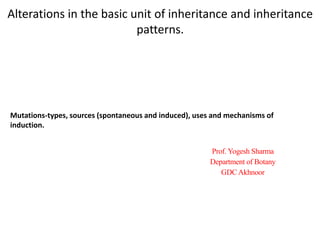
Alterations in the basic unit of inheritance and patterns
- 1. Alterations in the basic unit of inheritance and inheritance patterns. Prof. Yogesh Sharma Department of Botany GDC Akhnoor Mutations-types, sources (spontaneous and induced), uses and mechanisms of induction.
- 2. Mutation Introduction: Sudden change in genetic material or character of an organism is known as mutation. Individuals showing these changes are known as mutants. A mutation occurs when a DNA gene is changed or damaged in such a way as to alter the genetic message carried by that gene. An individual showing an altered phenotype due to mutation are known as variant. Factor or agents causing mutation are known as mutagens.
- 3. A mutagen is an agent of substance that can bring about a permanent alteration to the physical composition of a DNA gene such that the genetic message is changed. Mutation which causes change in base sequence of a gene are known as gene mutation or point mutation The gene mutations are the only source of new genetic variability, and without them evolution could not progress for a long time. Mutant gene do not become expressed immediately because most of them are recessive.
- 4. History Seth Wright recorded case of mutation first time in 1791 in male lamb with unusual short legs (Ancon breed). 1901- Hugo deVries first used the term mutation to describe the sudden heritable phenotypic change in evening primrose Oenothera lamarckiana. Systematic study of mutation was started in 1910 when Morgan genetically analyzed white eye mutant of Drosophila. H . J. Muller performed induced mutation in Drosophila by using X-rays in 1927; he was awarded with Nobel prize in 1946.
- 5. KINDS OF MUTATIONS • There exists a lot of controversy about the possible kinds of mutations among geneticists. • They have been classified variously according to different Criteria.
- 6. • Classification of Mutation According to Type of Cell 1. Somatic mutations. 2. Gametic mutations. • Classification of Mutations According to the Size and Quality 1. Point mutation:- Deletion, Insertion/addition,substitution mutations. 2. Multiple mutations or gross mutations-Translocation & Inversion. • Classification of Mutation According to the Origin 1. Spontaneous Mutations 2. Induced Mutations.
- 7. • Classification of Mutation According to the Direction 1. Forward mutations. 2. Back/Reverse mutations • Classification of Mutation According to Magnitude of Phenotypic Effect 1. Dominant mutations 2. Recessive mutations 3. Isoalleles 4. Lethal mutations
- 8. • Classification of Mutation According to Consequent Change in Amino Acid Sequence 1. Missense mutations 2. Nonsense or chain termination mutations 3. Silent mutations • Classification of Mutation According to the Types of Chromosomes 1. Autosomal mutations 2. Sex chromosomes mutations
- 9. Spontaneous Mutation • Spontaneous mutation occur frequently in nature without any cause. • During the study heredity since1900, Spontaneous mutation have been recognized in a large number of organisms. • Various species of Drosophila have contributed the greatest number of gene mutations. Hundreds of normal genes and their mutant alleles are known in these flies. • The known gene mutations in Drosophila are those causing white eyes, pink eyes, black body colour, yellow body colour and vestigialwings. • Similarly in man, many characters as hair colour, eyes colour, skin pigmentation and several body deformities are due to mutant gene.
- 10. Induced Mutations • Induced mutations are alterations in the gene after it has come in contact with mutagens and environmental causes. • Induced mutations artificially through the use of radiations, chemicals and other agent. • It has been shown that the mutation rate can be raised well above the spontaneous rate by various experimental procedures. • Temperature shocks were one of the first methods used to raise the mutation rate. • In Drosophila, short exposures to both low and high temperature extremes outside the normal range result in higher rate of mutation.
- 11. • X-rays and other ionizing radiations (alpha, beta and gamma rays) induce mutations and cause chromosomal breakage.At present, X-rays are considered to be the most effective physical mutagens. • Several chemicals are also strongly mutagenic. The chemicals like formaldehyde and urethane when mixed with food on which Drosophila larvae grow cause mutations. • caffeine, phenol and several cancer producing compounds cause mutations. • Mutations are also produced by the analogues of DNA bases e.g., 5-Bromouracil, 5 Chlorouracil, which are incorporated into newly formed DNAstrands.
- 12. PRACTICAL APPLICATIONS OF MUTATIONS • Mutations are generally deleterious and recessive for the organisms, therefore, majority of them are of no practical value. • A. Gustafsson has estimated that less than one in 1000 mutants produced may be useful in plant breeding. • In India, several useful mutations of various cereals and other crop plants have been developed
- 13. • In bread wheat, many useful mutations have been obtained and utilized in plant breeding, e.g., branched ears, lodging resistance, high protein and lysine content, amber seed colour and awned spikelets. • In rice, one of the high yielding varieties Reimei was developed through mutations isolated after gamma irradiation. Certain developed mutants of rice are found to contain increased contents of proteins and lysine. In certain other mutant rice the duration of crop was reduced by as many as 60 days. • In barley, mutations called erectoides and eceriferum have been induced. These mutants had high yields including several useful characters.
- 15. Tha nk you